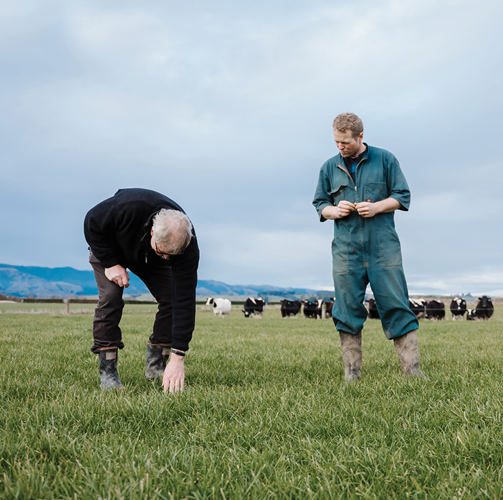

Measure & Manage in Autumn, Succeed in Spring
Words by Dr. Ma. Elena Duter – Head of Agronomy Technical Field Growth
Getting your agronomy system right is a year-round commitment. With the climate outlook for 2025 uncertain, measurement and management will be crucial for success, writes Dr. Ma. Elena Duter, Head of Agronomy Technical Field Growth at Farmlands.
You can manage when you know what you have. Measuring, calculating, and allocating will be key activities transitioning into an unpredictable season.
Important ingredients for success this year will include: the right feed availability for stock class and allocation; the right cropping system; resilient species; water reticulations and storage systems, and timing.
Pasture Management
During the spring season, pastures experience a peak of growth. However, as we transition into summer, the growth rate and quality decrease due to the seasonal development, accentuated by the drying environment and less available water, even more on dryland systems. Harvesting pasture surplus to cover feed deficiencies in the future becomes essential when unpredicted weather events are on the horizon. With these weather variabilities, measuring growth and predicting total yields regularly and frequently becomes necessary to achieve accurate feed allocations.
These fluctuations create challenges when determining the appropriate grazing levels and rotation lengths, as we lose consistency in those patterns. The combination of high air temperatures and low moisture levels can lead to the accumulation of dead tillers in the pasture base. While this may increase the dry matter percentage and fibre content, it reduces the overall pasture quality.
On the other hand, high temperatures and high moisture levels create the perfect environment for pests and diseases. Managing pest pressure on time will maintain quality and yield. This requires an upfront investment but will yield undoubted long-term economic benefits. Overgrazing depletes the plant's energy reserves, mainly stored in the bottom 4cm of the grass plant, hence your feed availability for the upcoming spring. On the other hand, undergrazing should also be avoided if aiming to maintain pasture quality and persistence. High grass residual levels will lead to a decline in pasture quality, slower growth rates, and consequently lessen animal production.
Feed management will need to have a broad approach considering animal intake and body condition scores, supplementation, water quality and supply, animal husbandry, and well-being to reach optimum pasture usage gaining the targeted weight gains in less time on the farm while preserving the environment. What about considering and planning possible stocking rate variations on our farms predicting positive or negative weather changes?
Have an action plan. Think about paddock selection; new pasture species available in the market; pasture systems and cropping rotations. Also consider relocation of pasture production to maintain optimum quality and utilisation, while fine-tuning the quality and quantity of supplements offered if conditions change dramatically.
Planning for possible scenarios will lead to better managing our system resulting in no surprises when they need to be actioned. Being and having an agile and flexible system will help the success.


Water Efficiency
To improve the efficiency, explore ways to enhance its effectiveness. It is crucial to measure your water usage for effective management. Install devices that enable you to monitor and track your water consumption, and quality in the system regularly. Checking and setting the right infrastructure to achieve optimums has to be on the to-do list.
Crop Management
While occasional dry spells are manageable, long-term climate changes require proactive measures. If your region is experiencing a sustained decline or excess in rainfall, it is essential to act now. Transitioning to cropping systems less reliant on water and considering planting alternative species that are dryland tolerant. Deep tap-rooted crops will help explore and harvest water from lower soil profiles in your paddocks, making them resilient to periods of no rainfall. Paddock selection is important when using high water-demanding crops, identifying topographically the best areas for grazing or feeding out will play a part. Strategically planning your rotation, avoiding damaging paddocks due to flooding, sacrificing paddocks for feeding, and preserving your best and newest pastures will help overcome permanent losses of yield and paddock quality.
Be Prepared
Planning is key to surviving wet or dry spells with minimal impact on future production. Develop a comprehensive plan that includes feed supply assessments and livestock conditions. Regularly monitor your farm's performance and rainfall against the plan, taking early action if any shortfalls or excesses are observed. Relying on hope alone is not a viable strategy. By preparing in advance and establishing a plan in collaboration with our agronomy team, you can mitigate the effects of substantial paddock damage due to excess water or drought. It is prudent to anticipate and prepare for extended wet or dry periods if we will be experiencing the La Niña effect in the upcoming months.

